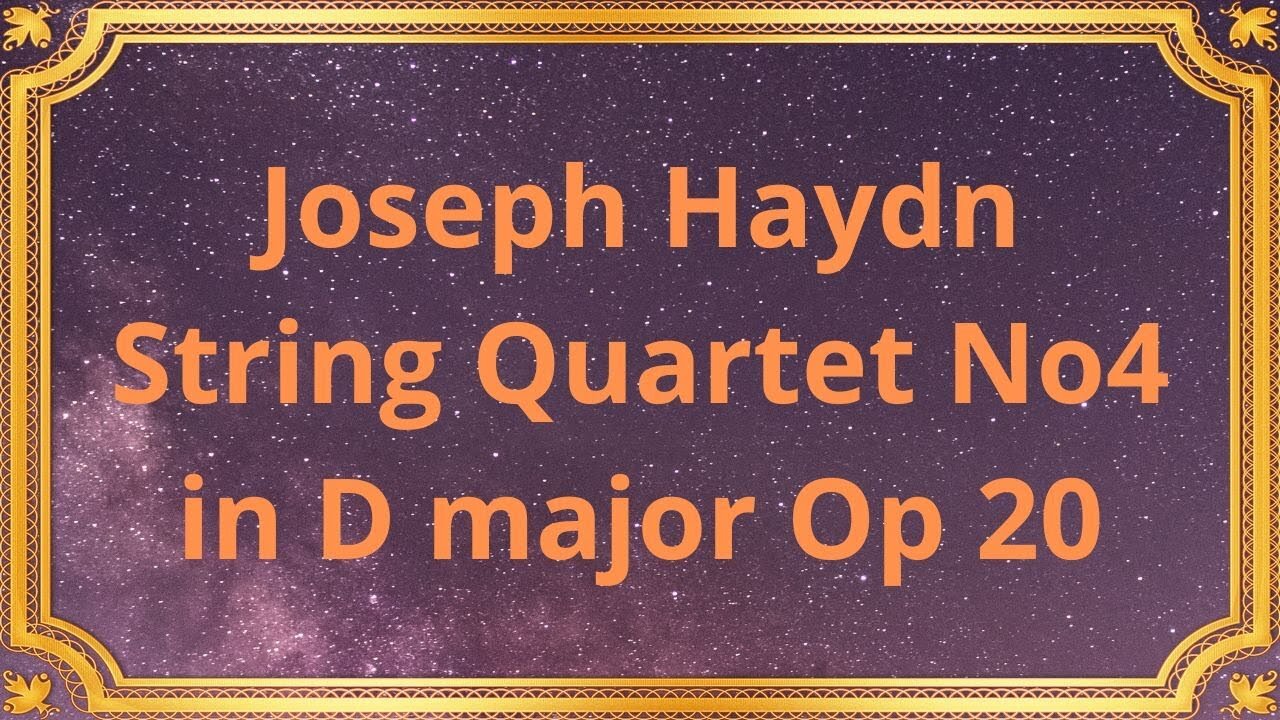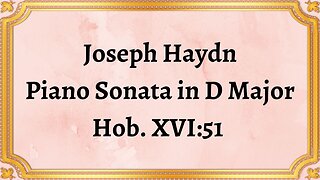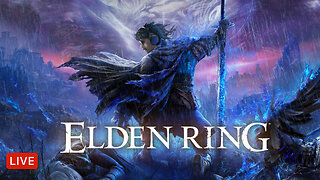Premium Only Content

Joseph Haydn String Quartet No4 in D major Op 20
#JosephHaydn #StringQuartet #Dmajor #Op20 #classicalmusic #musicalcomposition #SunQuartets #historicalcontext #musicalcharacteristics #lastingimpact #virtuosity #craftsmanship
JOSEPH HAYDN COMPLETE STRING QUARTETS OF OP20
"The Sun Quartets"
Publication date 1952
SCHNEIDER QUARTET
Alexander Schneider, First Violin
Isidore Cohen, Second Violin
Karen Tuttle, viola
Madeline Foley, violoncello
The world of classical music is enriched by countless masterpieces, and among them shines the exceptional "Joseph Haydn String Quartet No. 4 in D major, Op. 20."
Composed in 1772, Joseph Haydn's String Quartet No. 4 in D major, Op. 20 is part of a set of six string quartets known as the "Sun Quartets." These quartets marked a turning point in Haydn's career, showcasing his increasing maturity and experimentation with form, harmony, and expression. Dedicated to his patron, Prince Nikolaus Esterházy, these quartets solidified Haydn's reputation as a leading composer of his time.
Haydn's String Quartet No. 4 in D major is a captivating four-movement piece that exemplifies the composer's mastery of the string quartet genre. The opening movement, marked Allegro di molto, bursts forth with energy and enthusiasm. The first violin introduces a vibrant theme, which is then passed seamlessly between the instruments, creating a sense of conversation and unity.
The second movement, marked Un poco adagio affettuoso, offers a contrasting atmosphere with its tender and melancholic character. Haydn's gift for writing expressive melodies is evident in this movement, as the quartet weaves a poignant and emotionally charged narrative. The interplay between the instruments creates a delicate balance, evoking a sense of introspection and contemplation.
The third movement, marked Scherzando: Allegro, provides a delightful and playful interlude. This movement showcases Haydn's wit and humor, with lively rhythmic patterns and unexpected melodic twists. The quartet engages in a spirited dialogue, filled with moments of musical jest and camaraderie.
The final movement, marked Presto e scherzando, brings the quartet to a thrilling conclusion. It is a display of technical brilliance, featuring rapid passages, intricate harmonies, and dynamic contrasts. Haydn's command of form and structure is evident as the quartet navigates through a series of exhilarating musical episodes, building tension and excitement until the triumphant finale.
"Joseph Haydn String Quartet No. 4 in D major, Op. 20" holds a significant place in the history of classical music. Haydn's innovative approach to composition, his exploration of form and expression, and his impeccable craftsmanship influenced generations of composers. This quartet, along with the other "Sun Quartets," paved the way for the development of the string quartet genre, inspiring composers such as Mozart, Beethoven, and beyond.
Conclusion:
In conclusion, "Joseph Haydn String Quartet No. 4 in D major, Op. 20" stands as a testament to Haydn's brilliance as a composer. Its historical significance, musical characteristics, and lasting impact make it a true gem of classical music. This quartet continues to captivate audiences with its beauty, depth, and technical virtuosity, reminding us of Haydn's enduring legacy and his profound contribution to the world of music.
You have the opportunity to support the channel:
https://destream.net/live/RadSiarAl/donate
https://www.buymeacoffee.com/6355radsiaral
-
 6:07
6:07
Classical music_Music Inspiration
23 days agoJoseph Haydn Piano Sonata in D Major, Hob. XVI:51
701 -
 20:11
20:11
Candace Show Podcast
1 hour agoBecoming Brigitte: Candace Owens x Xavier Poussard | Ep 6
45.9K133 -
 LIVE
LIVE
Dr Disrespect
6 hours ago🔴LIVE - DR DISRESPECT - ELDEN RING DLC - REVENGE
3,738 watching -
 1:01:52
1:01:52
In The Litter Box w/ Jewels & Catturd
23 hours agoBest Presidents' Day Ever! | In the Litter Box w/ Jewels & Catturd – Ep. 743 – 2/17/2025
70.1K41 -
 1:29:15
1:29:15
Simply Bitcoin
6 hours ago $6.51 earnedThey JUST Triggered A Global Gold Rush: $1M Bitcoin is coming! | EP 1184
68K22 -
 1:50:47
1:50:47
The Quartering
6 hours agoElon Musk's 13th Baby, Trump Attends Daytona 500, and Ramaswamy Enters the Ohio Governor's Race
91.2K35 -
 1:28:04
1:28:04
Russell Brand
6 hours agoBREAKING: UK Troops To Ukraine | Zelensky Wants “Army Of Europe” | JD Vance SLAMS EU Tyranny – SF538
164K49 -
 1:46:20
1:46:20
Benny Johnson
7 hours agoPANIC: Feds FLEE DC After Mass PURGE, Fired USAID Activists EXPOSED | Trump DOMINATES Daytona 500
153K155 -
 1:58:43
1:58:43
The Charlie Kirk Show
5 hours agoCBS Steps In It + Hockey Brawl + Judicial Standoff | Yoo, Schlapp, BigTree | 2.17.2025
147K42 -
 1:01:26
1:01:26
The Dan Bongino Show
8 hours agoTrump Is Cancelling DEI And Cancel Culture (Ep. 2424) - 02/17/2025
908K1.72K